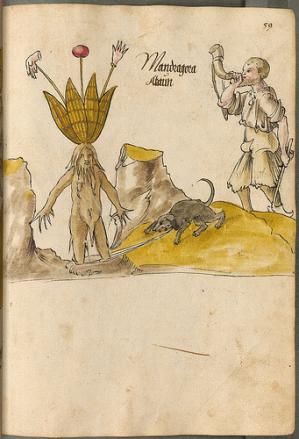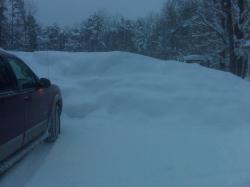Ghost towns are no big deal, really. There’s plenty of them out west, and most states have at  least a handful of their own (my home state of Ohio has more than a dozen, including the interestingly-named
least a handful of their own (my home state of Ohio has more than a dozen, including the interestingly-named
An illustrated guide to herbalism
Herbalism, the traditional medicinal practice which uses plants, fungi, and extracts to treat illnesses and injury, dates back at least 5,300 years (and is no doubt much older). During the Middle Ages and well into the Renaissance, herbalism was the cutting edge of medicine in Europe and elsewhere (even while the seeds of modern medicine were taking root in the Middle East).
illnesses and injury, dates back at least 5,300 years (and is no doubt much older). During the Middle Ages and well into the Renaissance, herbalism was the cutting edge of medicine in Europe and elsewhere (even while the seeds of modern medicine were taking root in the Middle East).
incorporate elements from folklore (the crossbow is from an age-old
legend, for instance), witchcraft and alchemy (the traditional
anthropomorphic Mandragora* – mandrake – and zoomorphic root forms) and the often stylised appearance of the plants suggest the manuscript artist may have been copying from earlier works.
Pictured here is an example of the anthropomorphized mandrake. The mandrake, of the plant genus Mandragora, belongs to the nightshades family and, according to wikipedia, “contains deliriant hallucinogenic tropane alkaloids such as hyoscyamine.” Mandrake roots, of course, have “long been used in magic rituals, today also in neopagan religions such as Wicca and Germanic revivalism religions such as Odinism.”
Apparently there exists a “simulated death” industry.
… And it’s thriving in South Korea, of all places. The LA Times reports that
Across South Korea, entrepreneurs are holding controversial forums aimed at teaching clients how to better appreciate life by simulating death. They use mortality as a personal motivator.…[At] the Coffin Academy, South Koreans can get a glimpse into the abyss. Over four hours, groups of a dozen or more tearfully write their letters of goodbye and tombstone epitaphs. Finally, they attend their own funerals and try the coffin on for size.
Interesting stuff. The article, which you can read in its entirety here, goes on to note that this is partially in response to the fact that South Korea has the highest suicide rate in the developed world.
What is The Bloop?
“The Bloop,” according to the ever-dependable Wikipedia, is an “ultra-low frequency and  extremely powerful underwater sound detected by the U.S. National Oceanic and Atmospheric Administration several times during the summer of 1997.” The sound’s source, mysteriously, still remains unknown.
extremely powerful underwater sound detected by the U.S. National Oceanic and Atmospheric Administration several times during the summer of 1997.” The sound’s source, mysteriously, still remains unknown.
So what produced The Bloop? An impossibly large whale? Otherwise-undetected geological activity on the ocean floor? A secret Russian weapon? Speculation abounds, and some, turning to the work of author H.P. Lovecraft, have offered a more controversial explanation: Cthulhu. BloopWatch.org points out the similarities to the famous creature of the Lovecraft mythos:
The sound is believed to be coming roughly from 50oS; 100oW. After
reading that, I wondered how close that was to the coordinates given in
“The Call of Cthulhu”. Allow me to quote: “Then, driven ahead by
curiosity in their captured yacht under Johansen’s command, the men
sight a great stone pillar sticking out of the sea, and in S. Latitude
47°9′, W. Longitude l23°43′, come upon a coastline of mingled mud,
ooze, and weedy Cyclopean masonry which can be nothing less than the
tangible substance of earth’s supreme terror – the nightmare
corpse-city of R’lyeh, that was built in measureless aeons behind
history by the vast, loathsome shapes that seeped down from the dark
stars.”Gotta love it!
Whatever made it, you can listen to The Bloop yourself here. Personally, this whole thing gives me chills. The uncharted depths of the ocean are a scary, mysterious place.
Life in the Snowbelt
 Northeast Ohio (where I hail from) has seen more than a week of non-stop snow, and as I write this, freezing rain is glazing the deep drifts like a mad baker on a donut-spree. Except this glaze is dangerous, not delicious, and the snow itself is far less delightful than dessert pastries. I may sound bitter, or perhaps unhinged, but a couple decades in the Snow Belt will do that.
Northeast Ohio (where I hail from) has seen more than a week of non-stop snow, and as I write this, freezing rain is glazing the deep drifts like a mad baker on a donut-spree. Except this glaze is dangerous, not delicious, and the snow itself is far less delightful than dessert pastries. I may sound bitter, or perhaps unhinged, but a couple decades in the Snow Belt will do that.
Snow and cold weather have recently propelled the Southern United States into the headlines (apparently it’s so cold, iguanas are falling out of the trees – not to mention, of course, the very real threat of crop failure). I defy anyone to show me a headline highlighting heavy snowfalls in the Great Lakes region (the one above doesn’t count, cheater). There aren’t any, because it’s not really news – just another day in the life for those of us here in the Snowbelt.
The Great Lakes Snowbelt is so snowy due to – surprise! – the Great Lakes. Much of the Snowbelt receives more than 100 inches of snow per year; some places regularly see more than 150 inches annually (the record winter for my hometown of Chardon, OH, ’59-’60, saw 161.45 inches, followed closely by what my family calls the Great Snow of ’96). These impressive tallies are made possible by a mechanism known to meteorologists and the denizens of the Snowbelt as lake-effect  snow. Basically, cold air blows over the warm lakes and collects moisture, which it then releases on their southeastern shores in the form of snow. This continues until the lakes freeze. Sometimes they don’t freeze at all. Even when they do, though, we’re still not safe: iced-over lakes couldn’t stop the deadly Great Lakes Blizzard of 1977, which occurred when strong winds blew accumulated powdered snow off of frozen Lake Erie (little new snow actually fell – but winds of 60 mph made that fact irrelevant).
snow. Basically, cold air blows over the warm lakes and collects moisture, which it then releases on their southeastern shores in the form of snow. This continues until the lakes freeze. Sometimes they don’t freeze at all. Even when they do, though, we’re still not safe: iced-over lakes couldn’t stop the deadly Great Lakes Blizzard of 1977, which occurred when strong winds blew accumulated powdered snow off of frozen Lake Erie (little new snow actually fell – but winds of 60 mph made that fact irrelevant).
Really, though, it’s silly to complain. There’s nothing we can do about it, and it makes the region rather unique – supposedly the only other comparable places in the world, in terms of winter weather, are the west side of the Japanese island of Hokkaido and the west side of Russia’s Kamchatka Peninsula (other spots like Salt Lake City, of course, experience lake-effect snow, but to a considerably lesser degree). And it toughens us up, too; no matter where I go, barring the Himalayas, Siberia, or the above, the winter weather won’t seem half as bad by comparison.
At any rate, though, those southern iguanas have little to grumble about. They should try a winter up here sometime.
156 countries sing “All You Need Is Love” to promote AIDS awareness
You can watch the video, which is very fun and well done and awareness-raising, here.Thanks to Today’s BIG Thing for pointing this out.
Welcome to the new year! Now how do we say it?
The nefarious Noughties are over as of 12:01 this morning – a welcome end to what most Americans consider the worst decade in 50 years, according to a recent Pew Research Poll.
The debate is now on, of course, as to how to pronounce the year we’re living in. Some experts suggest that we used the “two-thousand-and” formulation to pronounce the years 2000-2009 mainly due to the influence of the 1968 film “2001: A Space Odyssey” (which also used the “two-thousand-and” formulation). This issue was discussed briefly on NPR two months ago:
SIEGEL: And then what? What do we call the year that kicks in when the
ball comes down? The four digits, 2-0-1-0, are not in dispute, but how
we say them evidently is. Is it two-thousand ten or twenty-ten? We’ve
checked our own airwaves, and we find them to be, as you might expect, impeccably balanced.[…]Mr.LASSER: I think when you put the year, when it’s describing
something, like the nineteen-eighty-five Bears, the fiercest team ever,
if you’re when the year is describing a noun, I think you can go into
the truncated version. So if you said the twenty-ten Nike super shoe,
like that’s fine, but when you talk about the year on itself, like a
noun, like a proper noun, like a person, like a citizen, it would be
two-thousand and ten.SIEGEL: As in the great twenty-ten controversy. What shall we call the year two-thousand ten?
Personally, “twenty-ten” still doesn’t sound right. I think it’ll be “two-thousand-” for me until at least 2013 or so. I’m gonna propose right now, though, that we call this decade the “two-thousand-teens” (say it fast). Not too original, but it has a nice ring to it.
Unusual, neglected, and/or lost literature
Are you, like me, tired of the New York Times Best-seller lists? Are you at a loss for reading material, and perhaps looking for books that are less mainstream, maybe off the beaten path? Stephen K. Baum, PhD, of Texas A&M University, has compiled an expansive, annotated list of interesting lesser-known literature. The list itself spans more than 300 pages, and includes a helpful sub-list of other lists of lesser-known books, too (my favorite of these are the 50 Essential Alternative Horror Books, the Guide to 20th Century Experimental Literature, and The Invisible Library – a list of fictional books that appear within other books).
at the moment is: stuff I like that’s a little or a lot different than most of the stuff you’ll
find down at the local Books’R’Us”.
Scientists find hints of dark matter at the bottom of a mine
Scientists searching for evidence of the existence of dark matter, the hypothetical matter theorized to account for the majority of the observable universe’s mass, have found vague but intriguing clues at the bottom of a Minnesotan mine:
An international team of physicists working in the bottom of an old
iron mine in Minnesota said Thursday that they might have registered
the first faint hints of a ghostly sea of subatomic particles known as dark matter long thought to permeate the cosmos.The particles showed as two
tiny pulses of heat deposited over the course of two years in chunks of
germanium and silicon that had been cooled to a temperature near
absolute zero. But, the scientists said, there was more than a 20
percent chance that the pulses were caused by fluctuations in the
background radioactivity of their cavern, so the results were
tantalizing, but not definitive.
You can read the rest of the article here.
Ancient whale ate mud
Well, not exactly. Mammalodon, who vaguely resembles a manatee and lived at least 25 million years ago,
fed by sucking small animals out of the seafloor mud with its short snout and tongue,
experts say.
Researchers say the 25 million-year-old fossil is related to today’s blue whales – the largest animals on Earth.
The ancient animal’s mud slurping may have been a precursor to the filter feeding seen in modern baleen whales.
These whales strain huge quantities of tiny marine animals through specialised “combs” which take the place of teeth.
The research is published in the Zoological Journal of the Linnean Society.
You can read the full article here.
Man’s friends gift wrap his possessions in Christmas prank
Merry Christmas to all! The Courier-Post Online reports that
A Chicago man could be unwrapping the hundreds of Christmas gifts spread around his apartment for days, even weeks.Trouble
is, they aren’t really presents. They’re his own belongings
meticulously wrapped by friends as a prank while he was out of town.
Louie Saunders’ packages contain everything from couch cushions to the beer in his refrigerator.
His friend Adal Rifai masterminded the scheme after Saunders gave him a
spare key. It took 16 people, 35 rolls of wrapping paper and eight
hours to finish the job.
Saunders tells the Chicago Sun-Times he’s only been able to unwrap about 10 percent of the packages.He jokes that the upside is that, with each package he unwraps, he finds something inside that’s just what he needs.
Talk about spreading holiday cheer! You can read the original article here.
Santa’s origins are political, too

Image via Wikipedia
While the earliest roots of the Santa Claus mythology likely trace back to European pagan traditions co-opted and combined with the story of the Christian bishop Nicholas of Myra, as we noted on Tuesday, the modern American conception of Santa Claus has its origins in politics. Stephen Heller of AIGA writes:
Santa did not become the universal Claus until 1863, when the American political cartoonist Thomas Nast, creator of the Democrat donkey and Republican elephant, rendered the quintessential Christmas icon in pen and ink.
The Bavarian-born Nast originated this archetype while working for New York’s Harper’s Weekly
in an attempt to spiritually uplift Union Army soldiers and their
families who made sacrifices during the darkest days of the bloody
Civil War.
Nast’s iconic illustration is pictured above.You can read the rest of Heller’s article here.

